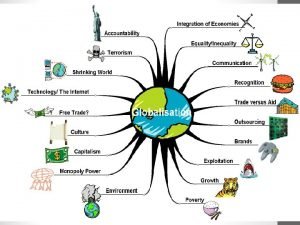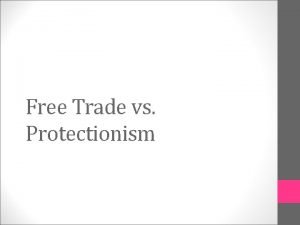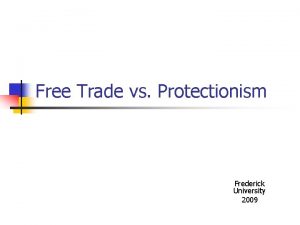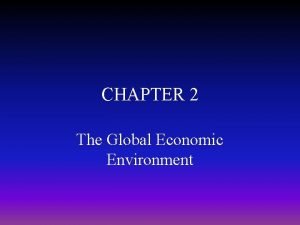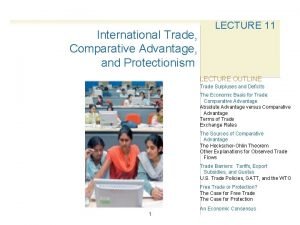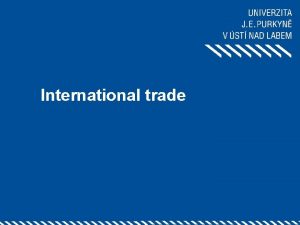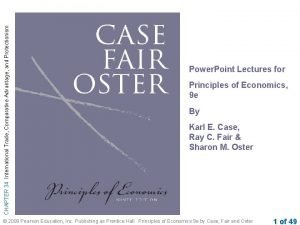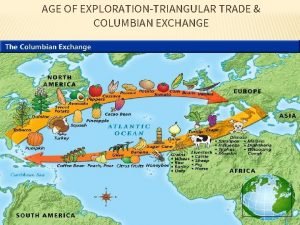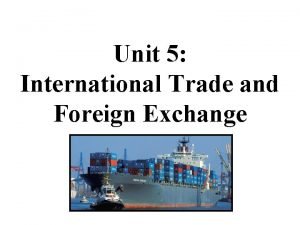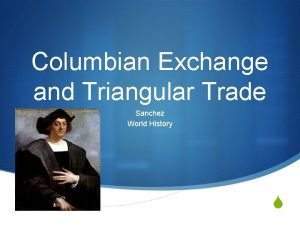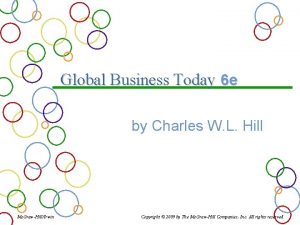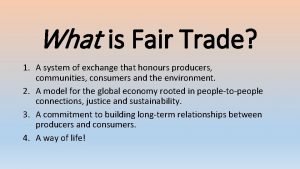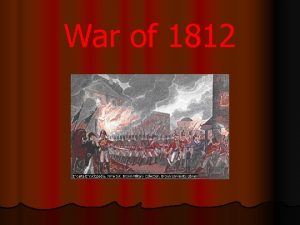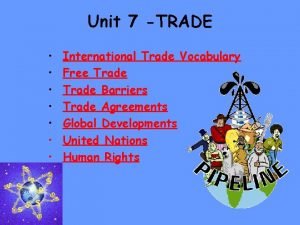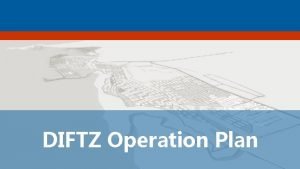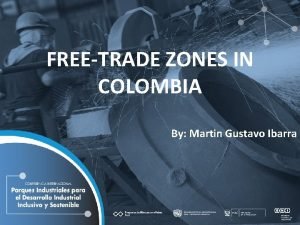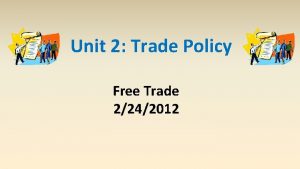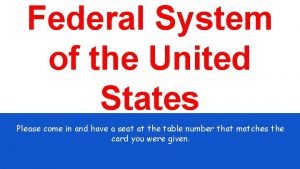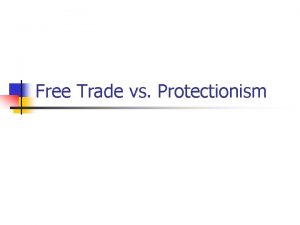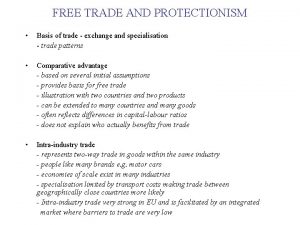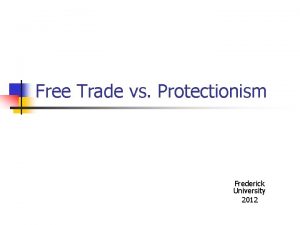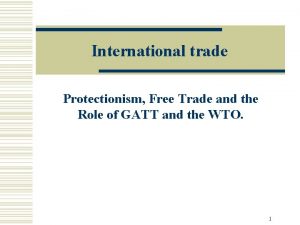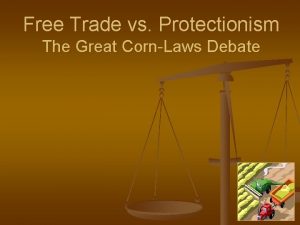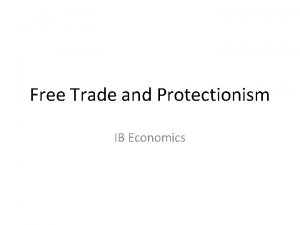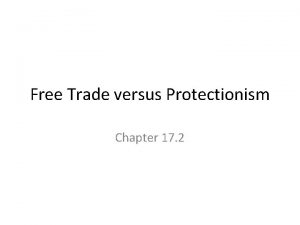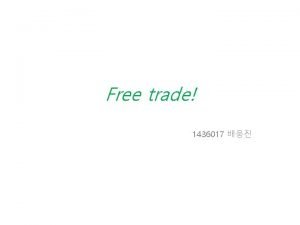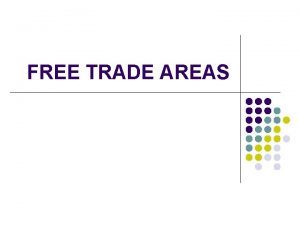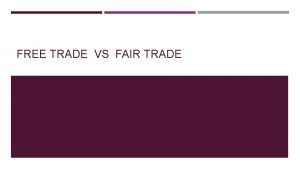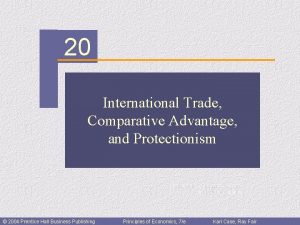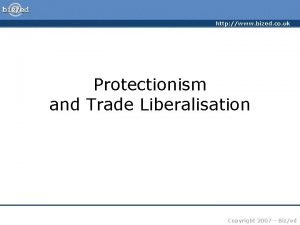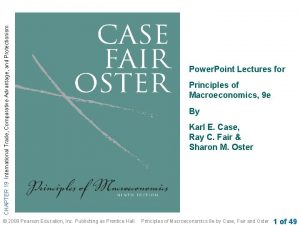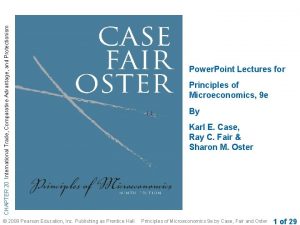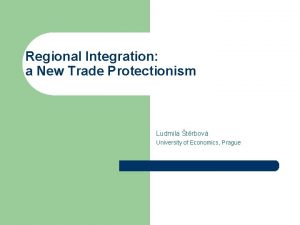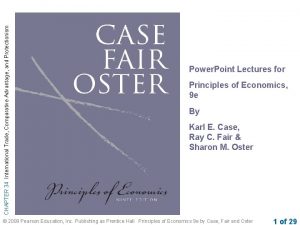Free Trade vs Protectionism Free trade exchange of


































- Slides: 34


Free Trade vs. Protectionism • Free trade = exchange of goods and services between nations without any restrictions ( barriers) imposed by the government • Free trade, according to theory of comparative advantage (and absolute advantage), leads to an efficient global allocation of resources and maximization of global output with all countries sharing the benefits of trade • But need to consider the types of “barriers to free trade” and reasons for imposing them

Trade Protection • Trade protection involves government intervention in free trade (barriers)to prevent the free entry of imports into the country or assist exports • There are four main types of barriers: – Tariffs or taxes on imports – Quotas or legal restrictions on the number/quantity of imports – Subsidies to firms who must compete with imports or to firms who would need to export their goods abroad – NTBs (non-tariff barriers) are administrative rules, excessive documentation, labelling requirements etc that impede trade deliberately

Tariffs • Tariffs, also known as ‘customs duties’ are taxes on imported goods • most common form of trade restriction Page 7 of H/O + new document and Page 10 (#2) • Tariffs serve two main purposes: – To protect a domestic industry from foreign competition – To raise revenue for the government

Tariffs and Effects • The effects of tariffs are illustrated as follow: • Under free trade, the country accepts the world price Pw at which it produces quantity Q 1 (the intersection of world price and Sd) and the domestic consumers demand Q 4. It imports Q 4 – Q 1 • With the tariff (t), the price of the imported good rises to Pw + t, causing the domestic price of the good to rise above the world price by t • Due to the price rise, there is an increase in domestic quantity supplied, decrease in quantity demanded, and decrease in imports

Effects on Consumer and Producer Surplus

• Before the tariff: – Consumer surplus (CS) includes the areas: a + b + c + d + e + f ( representing the area under the demand curve and above the world price Pw) – Producer surplus (PS) is the area g (below the price producers receive (Pw) and above the supply curve) – Social surplus is: a + b + c + d + e + f + g • After the imposition of the tariff: – – CS drops to areas: a + b indicating how consumers are worse off PS increases to areas: c + g indicating how producers are better off The government gains the revenue equal to area: e Social surplus after the tariff is areas: a + b + c + e + g

Effects of Tariffs on Different Stakeholders • Consumers: – Domestic consumers are worse off as they pay a higher price for smaller quantity of production of Q 3 (rather than Q 4) • Producers: – Domestic producers are better off as they can sell at a higher price Pw + t and sell a larger quantity of goods at Q 2 (rather than Q 1) • Government: – The government (of the importing country) is better off as it gains tariff revenues which is the product of tariff per unit of import times the amount of imports

• Comparing the social surplus before and after the tariff, it has decreased by areas: d + f which represents the welfare loss to the society. It is the misallocation of resources caused by increased production by inefficient domestic producers (area d) and decreased consumption of consumers (area f)

Other stakeholders affected. . • Foreign producers are worse off – The producers of exporting countries (with a comparative advantage ) are worse off because whereas they receive the world price Pw (importers pay them Pw and sell it later for Pw + t in their country), they export a smaller quantity of goods • Global misallocation of resources – The decrease in production, shift of production away from more efficient foreign producers and towards more inefficient domestic producers indicate a misallocation of resources both domestically and globally (WL at the global scale as well) • Note: when we do this type of analysis, make sure to anchor your perspective in one country. And distinguish stakeholders in the domestic and foreign countries and define exports and imports consistently!

Quotas • Quota is a physical limit on the volume or value of goods that can be imported into a country over a particular period of time • e. g. US imposes quotas on sugar and products with more than 65% sugar content; Tobaccco; Peanuts and peanut butter; Many specific dairy products (e. g. powdered milk, baby formula); Cotton; Beef; Tuna, Olives; Mandarin oranges; etc. www. customs. gov • Japan has quotas on rice imports • H/O Page 8

Quotas and Effects (Group VI Friday) • The graphical illustration of quotas is as follows • Before the quota is imposed, Q 2 of wheat is purchased at a price of Pw. Domestic supply is Q 1 and imports are Q 1 Q 2 • If the government imposes a quota of Q 1 Q 3, foreign producers can only export Q 1 Q 3 of this good to this country

• Under the quota, domestic producers continue to supply Q 1 at price of Pw and imports are Q 1 Q 3 which is less than what they previously produced • The supply curve of wheat (sum of domestic and foreign production) for this country is now represented with a rightward shift by the amount of quota • However, once quota is imposed, there is an excess demand of Q 3 Q 2 at the price of Pw ). Through the price mechanism (interaction of D and S), the price would start to increase …………………. . next slide

• ………Price rises and adjustment process will continue until price settles at a equilibrium price of Pquota where D and S are equal • At this point of Pquota and Q 4, domestic producers now supply Q 1 AND Q 3 Q 4 tons of wheat at Pquota • Foreign producers continue to sell the quota of Q 1 Q 3 but now at the price of Pquota

Stakeholder Analysis • Consumers are worse off – Q 4 Q 2 amount of wheat is no longer purchased by consumers. There is a loss of consumer surplus (not transferred to others) by the area of k • Domestic producers are better off – The increase in domestic production at a higher price of Pquota increases the producer surplus of domestic firms • Foreign producers are likely worse off – The efficient producers can no longer supply as much good as before and have to sell less. But as the price is increased to Pquota, they could have earned more as well. But this depends on whethere is a quota license which the exporting country must purchase • Government unaffected – unlike in the case of tariff, there is no tax revenue generated with quota (unless they sell quota licences)

(continued) • The welfare loss to society is represented by two triangles which is the difference in the social surplus before and after the quota: – The triangle k represents part of the loss in consumer surplus through purchasing less of the good at higher price – The second triangle j represents loss in consumer surplus as Q 3 Q 4 tons of wheat is now sold at a higher price. But it also symbolizes inefficient production by the higher cost local producers protected by the quota, as Q 3 Q 4 quantity of good could have been produced more efficiently at a lower cost and price (Pw) by more efficient and competitive firms abroad. Unnecessary resources were used in the production of the good. global misallocation of resources. – BUT note DISAGREEMENT about areas h and i. They could be perceived as loss to the country as they represent extra revenues for the exporting country under the quota. But if the quota were licensed and the exporting countries would need to purchase these licenses (at price Pquota – Pw) then areas h and I are license revenue for the importing country. In either case, it would not change the global social surplus.

Subsidies • Subsidies=payment by the government to a firm for each unit of output produced • This leads effectively to a decrease in costs for each unit of output, represented by a downward shift of the supply curve • In the context of international trade, there are two kinds of subsidies: – Production subsidy which is intended to protect domestic firms that compete with imports – Export subsidy which is intended to protect domestic firms that export their goods abroad • Developed countries provide subsidies (hundreds of billions of dollars) to their agricultural sector to protect them from agricultural imports from economically less developed countries (ELDCs) – but WTO is advocating for free and fair trade • Analysis of production subsidies (H/O Page 9 with new sheet)

Production Subsidies-Effects • Production subsidies are payments per unit of output given by the government to domestic firms that compete with imports

• The subsidy causes the supply curve to shift downward to Sds • Goods continue to sell at Pw but with the following effects/differences in comparison to the case of free trade with no subsidy: – Increase in quantity supplied by domestic firms and decrease in imports – No change in the level of consumption at Q 2 – Negative effect on the government budget as tax revenue is spent by the amount of (Ps – Pw)x. Q 3

• Page 274 of your textbook (Notice that Pe. Qe not needed)

Stakeholder Analysis • Consumers are not affected – They continue to purchase Q 2 at Pw – But indirectly affected as government uses the tax revenue (opportunity costs of spending) + could be possible tax rise in the future • Domestic producers are better off – Domestic producers receive Ps (Pw + subsidy) at an increased production level of Q 3 • Domestic employment increases • Government is worse off – Tax revenue of (Ps – Pw)x. Q 3 is forgone as subsidy • Exporting firms abroad are worse off – They can export less of the good and export revenues have fallen • Less efficiency in production – Inefficient production by domestic firms increases while efficient production by foreign firms decrease – Foreign firms could have produced Q 1 Q 3 at lower – “Area g” =WL (misallocation of global resources)

Economists prefer subsidies over tariffs and quotas? • The effects of subsidies are not as harmful as those of tariffs and quotas, because, while they encourage inefficient production (similar to tariffs and quotas), they do not have negative effects on consumption which remains the same before and after subsidies • May encourage firms to invest in new tech. or to expand gain economies of scale (but may become complacent and dependent on subsidies) • For these reasons, (many) economists argue that subsidies are preferable form of protection • But still an opportunity cost in using the tax revenue

Extreme production subsidies which promote exports • If the production subsidy is large enough, the country may actually become an exporter of the good, even though it does not have a comparative advantage in its production

• The subsidy is large enough that Q 3 is now greater than Q 2 meaning that domestic production is greater than that needed to satisfy domestic quantity demanded of Q 2 • The extra quantity produced (Q 3 – Q 2) can therefore be exported • The effects are the same as the previous case but as the higher cost country (without comparative advantage) is now becoming the exporter of the good, producers abroad are hurt even more and this implies even greater misallocation of resources and inefficiency at the global scene

Export Subsidies -Evaluation • Similar to production subsidies as involve payment by the government • Increase domestic quantity produced, reducing imports, and increasing exports, ……… • = “dumping” (overseas price is lower than domestic price) • Lead to both domestic and global misallocation of resources • According to trade agreements under the WTO, export subsides are declared illegal but many countries continue to use them (eg for solar panels, steel, food)

Other Forms of Trade Barriers (NTBs) group VI Tues • In addition to tariffs, Tues quotas, and subsides, governments may impose a variety of additional obstacles to imports ---administrative barriers or non-tariff barriers (NTBs) – Bureaucratic barriers eg. massive amounts of paperwork and legal/translating requirements which take time and expense – Custom procedures involving inspections, valuation (determining the value of the good) + packaging and labelling regulations – Technical standards of imports with respect to health, safety, and environmental standards. Agricultural goods can include scientific tests e. g on imported beef

EVALUATION • Free Trade • versus • Protectionism

Arguments for Protection (vs Free Trade) 1) Risks of overspecialisation (especially in primary products) (Group III –Wed) • PED is ……………. . • Supply shocks more likely and difficult to adjust supply (PES is……… ) • …………. • YED is low (also due to the substitution by synthetic materials) • • Plus Agricultural markets in MDCs often still protected • Plus to develop in long run need to shift from emphasis on primary goods ………………. • Therefore, may need diversification

Arguments for Protection (vs Free Trade) (continued) 2) Infant industry (sunrise industry) argumentjustified if there are ………………… of ……………… 3) Sunset industry argument- justified if there is ………. . …………………. and …………… 4) tariff revenues - important for a ………. . 5) anti-dumping * ……………. . 6) Others - (probably not economically valid) to improve balance of payments; strategic trade policy; national security; health, safety, and environment standards

• *dumping = selling a good in international markets at a price that is • below the cost of producing it OR • below the price in the exporting country • (=price discrimination between domestic and overseas market) • (can occur when subsidised or when very large economies of scale)

• Arguments against trade protection=for Free Trade it worsens the allocation of resources and imposes a variety of costs on the domestic and the global economy – Domestic producers (who compete with imports) gain but higher costs of production and reduced efficiency. This is evident in all types of protection. It can lead to disincentives for the protected firms in the long run complacency and more inefficiency – Consumers are worse off in most cases except for subsides. This is due to higher prices of protected goods and less choice – Foreign producers are worse off in all cases as the quantity they can export has fallen – Society as a whole and global resource allocation are worse off under all forms of trade protection. Welfare loss is introduced in all forms because free trade (based on comparative advantage) achieves the greatest amount of production and consumption and allocative efficiency at the global scale (plus competition, economies of scale

(continued) • In addition: • Trade protection may have negative effects on a country’s export competitiveness (some of the domestically produced goods that are protected may be used as inputs for other goods which are exported) and overseas markets decline (eg 1930 s) • Trade protection may lead to RETALIATION and eventually trade wars (which will create serious negative effects on global output and resource allocation) • Trade protection creates a potential for corruption e. g. bribes, illegal smuggling, parallel markets etc.

Free trade vs. Protection • Trans-Pacific Partnership intends to enhance trade and investment among the TPP partner countries, to promote innovation, economic growth and development, and to support the creation and retention of jobs • Australia, Brunei, Canada, Chile, Japan, Malaysia, Mexico, New Zealand, Peru, Singapore, the United States, and Vietnam • Controversies: tariffs (taxes) on Japanese autos in the US, tariffs and regulations on the health and medical industry, tariffs on agricultural imports to Japan, copy rights and intellectual properties, etc. • What are the pros and cons of TPP?

The real world is a political economy world! • Depending on the philosophy, values, culture, and structure toward economics and the political parties in charge, the types of policies and the balance between economics (or markets) and the role of government intervention varies
 Free trade vs protectionism
Free trade vs protectionism Free trade vs protectionism
Free trade vs protectionism Protectionism in trade
Protectionism in trade Protectionism pros and cons
Protectionism pros and cons Protectionism definition economics
Protectionism definition economics Adam smith absolute advantage theory
Adam smith absolute advantage theory Advantages of protectionism
Advantages of protectionism Fair trade not free trade
Fair trade not free trade Gas exchange key events in gas exchange
Gas exchange key events in gas exchange Real exchange rate formula
Real exchange rate formula Voluntary exchange
Voluntary exchange Triangular trade columbian exchange
Triangular trade columbian exchange The columbian exchange and global trade
The columbian exchange and global trade Unit 5 international trade
Unit 5 international trade Triangular trade
Triangular trade Triangular trade video
Triangular trade video The trade in the trade-to-gdp ratio
The trade in the trade-to-gdp ratio Trade diversion and trade creation
Trade diversion and trade creation Trade diversion and trade creation
Trade diversion and trade creation Trade diversion and trade creation
Trade diversion and trade creation Tramp liner
Tramp liner Trade diversion and trade creation
Trade diversion and trade creation Is free trade fair? discuss
Is free trade fair? discuss Nafta
Nafta Xiv
Xiv Is free trade fair? discuss
Is free trade fair? discuss War of 1812 free seas and trade
War of 1812 free seas and trade Free trade no gospel
Free trade no gospel Vocabulary international trade
Vocabulary international trade Diftz
Diftz Colombia free trade zone
Colombia free trade zone Foreign trade definition
Foreign trade definition Free trade
Free trade Federalist vs anti federalist political cartoon
Federalist vs anti federalist political cartoon Standard free energy change
Standard free energy change
